In the 1960s, women's fur stoles embodied luxury and sophistication, often associated with fashion icons like Jackie Kennedy. These stoles, crafted from materials like mink and fox, became essential at formal events, perfectly complementing elegant evening gowns. As casual styles emerged, the stole's versatility allowed it to enhance everyday outfits, reflecting a shift in societal norms. Dyed furs in vibrant colors offered personal expression, while the rise of faux fur presented more ethical alternatives. This period marked a transformative phase in fashion, where glamour met conscious consumerism—further insights await as you explore the era's rich fashion landscape.
Fashion Trends of the 1960s
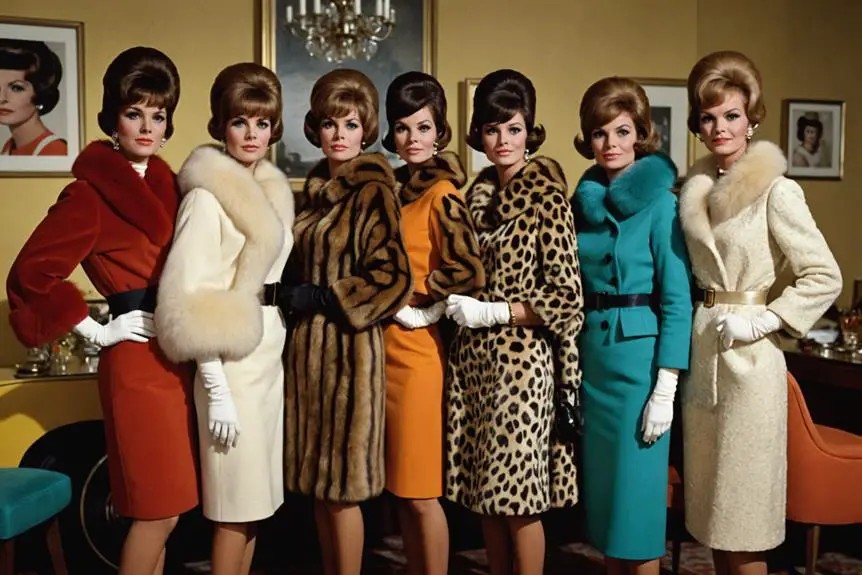
In the vibrant tapestry of the 1960s, fashion underwent a remarkable transformation, reflecting the cultural upheavals of the time. You'd notice a significant shift towards casual styles, driven by the youth culture revolution and counterculture movements. Figures like Jackie Kennedy and Audrey Hepburn stood at the forefront, popularizing elegant, tailored silhouettes that became synonymous with luxury and sophistication. The era also witnessed a growing interest in vintage clothing, where unique labels and craftsmanship became increasingly valued by collectors and fashion enthusiasts, highlighting the importance of vintage clothing labels.
As the miniskirt emerged as a bold fashion statement, it redefined styling norms. You'd see vintage fur stoles draped elegantly over shoulders, creating a chic contrast to the shorter hemlines that epitomized mod fashion. This era celebrated vibrant colors and unique designs in fur stoles, showcasing a playful embrace of fashion trends that matched the decade's spirit.
Fur stoles became symbols of glamour, often showcased at high-profile events and on red carpets, solidifying their status as essential accessories for the fashionable woman. The juxtaposition of these luxurious pieces with newfound casual styles encapsulated the essence of 1960s fashion, where sophistication met youthful exuberance, allowing you to express both elegance and modernity in your wardrobe.
Iconic Materials Used
The luxurious appeal of women's fur stoles in the 1960s stemmed from the iconic materials that defined this era. Real furs like mink, fox, and rabbit became staples, reflecting a fashion trend that embraced opulence. Vintage stoles often showcased the exquisite softness of Arctic fox and Persian lamb, prized for their warmth and luxurious feel.
Craftsmanship played a crucial role in the allure of these stoles, with intricate detailing enhancing their elegance. Many featured a satiny lining, offering not just a striking contrast but also an added layer of comfort.
The 1960s also marked a shift towards innovation, as dyed furs emerged, allowing fashion-forward women to choose from a vibrant palette, elevating their accessories and personal style. Faux fur gained traction as an ethical alternative, providing stylish, affordable options that closely mimicked the look and feel of real fur.
This blend of traditional and modern materials created an inclusive market for women, ensuring that whether they opted for luxurious real furs or fashionable faux alternatives, they could find a stole that resonated with their tastes and values.
Styles and Designs
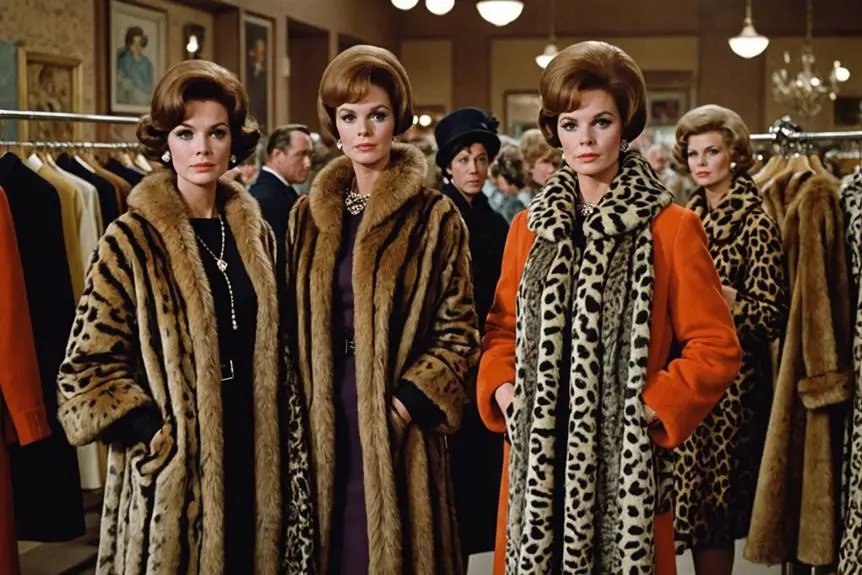
How did the styles and designs of women's fur stoles in the 1960s reflect the era's evolving fashion landscape? These luxurious accessories showcased a range of innovative styles, from extravagant capes to sleek wraps and elegant shawls. Crafted primarily from mink and fox fur, each stole served as a statement piece, enhancing the wearer's outfit. The decade's penchant for bold colors birthed dyed furs in pastel pinks and vibrant blues, allowing for unique expressions of individual style. As fashion evolved, influences from the history of luxury fashion brands became evident, with designers incorporating elements that elevated the sophistication of these stoles.
Intricate detailing became a hallmark of 1960s fur stoles, with satin linings and beaded embellishments adding a touch of glamour to evening wear. High-end designers like Saks Fifth Avenue and I. Magnin highlighted these vintage designs, signifying the luxurious fashion trends of the time. As the decade progressed, a shift toward more casual and bohemian styles emerged, resulting in a decline of full fur coats. This change led to a growing preference for versatile fur stoles, which could easily complement various outfits, allowing women to embrace both elegance and practicality. The designs of this era not only reflected personal style but also aligned with the broader cultural shifts in fashion.
Cultural Significance
During the 1960s, women's fur stoles emerged as a powerful cultural symbol, embodying the era's ideals of luxury and sophistication. The Fur Stole Shawl became synonymous with elegance, often sported by Hollywood celebrities and fashion icons at formal events. This association elevated its status, making it a coveted accessory that signified not just fashion sense but also a woman's social position. The materials and styles of stoles often reflected varying levels of wealth and taste, reinforcing a hierarchy within women's fashion. Moreover, the presence of vintage labels on these stoles can offer insights into their provenance and value, enhancing their allure among collectors and enthusiasts of vintage fashion. accurate information on vintage tags helps to appreciate the craftsmanship behind these garments.
As you explore the decade, you'll notice how fur stoles were seamlessly paired with the emerging A-line dresses and mod looks, bridging traditional luxury with contemporary aesthetics. However, by the late 1960s, cultural shifts began to challenge this norm. Growing awareness of animal rights and ethical considerations prompted many consumers to reconsider their fashion choices. This evolving consciousness led to a gradual decline in the popularity of real fur stoles, reflecting a significant transformation in societal values. Ultimately, while the stole represented an era of glamour, it also foreshadowed a broader dialogue about responsibility in fashion, marking a pivotal moment in women's fashion history.
Popular Events for Wearing
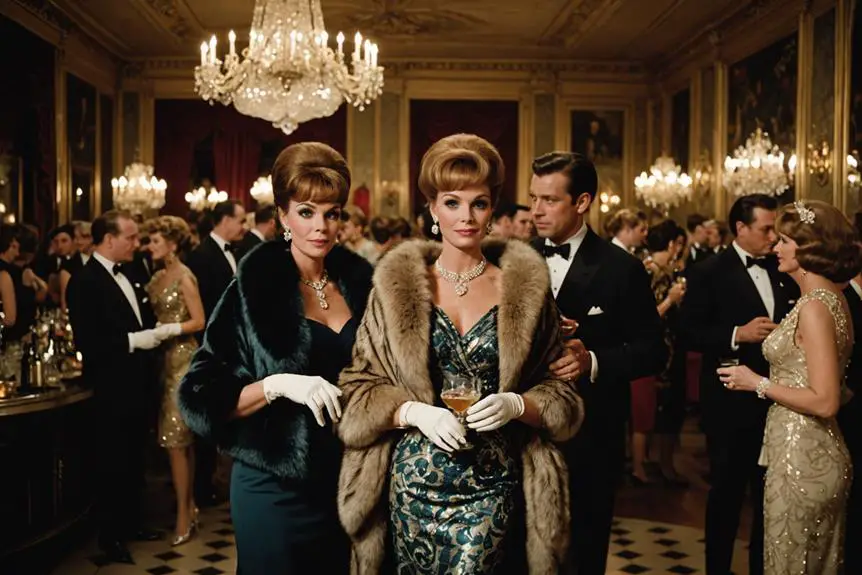
Women's fur stoles became synonymous with elegance at various upscale events throughout the 1960s, transforming these occasions into showcases of sophistication and style. Whether you were attending a wedding or a theater premiere, the addition of a vintage mink stole or a luxurious faux fur stole elevated your formal wear, making a powerful statement.
Winter parties and holiday celebrations provided the perfect backdrop for flaunting these glamorous accessories, as they not only offered warmth but also a chic flair. As cocktail culture blossomed during this era, women paired their evening gowns and cocktail dresses with fur stoles, creating a harmonious blend of comfort and elegance.
Fashion shows and charity events also served as prime venues for showcasing stylish fur stoles, with designers often featuring them prominently in their collections. The influence of Hollywood actresses, who adorned themselves with these stoles at red carpet events, propelled their status as a staple in women's evening wear. Ultimately, whether you opted for a wedding bridal faux fur or a classic vintage mink, wearing a fur stole in the '60s was more than a fashion choice; it was a declaration of sophistication and confidence.
Famous Figures and Fur Stoles
As fur stoles captured the essence of sophistication in the 1960s, they became the go-to accessory for numerous high-profile figures, including iconic actresses and influential political personalities. Audrey Hepburn and Elizabeth Taylor epitomized glamour with their exquisite choices in fur stoles, often draping themselves in luxurious mink and fox for red-carpet appearances and high-fashion events. This decade saw these stoles not just as garments but as statements of status and style.
Renowned designers like Valentino and Dior showcased fur stoles in high-fashion magazines, further cementing their place in elite wardrobes. These accessories were essential for evening wear, perfectly complementing elegant dresses for formal occasions. The vintage allure of fur stoles made them synonymous with sophistication, appealing to affluent women seeking to make a lasting impression.
Moreover, political figures like Jacqueline Kennedy Onassis embraced fur stoles, enhancing their association with elegance and high social standing. In a time when fashion was a powerful mode of self-expression, fur stoles emerged as a staple, reflecting the evolving trends of the 1960s while embodying a sense of luxury that defined the era.
Faux Vs. Real Fur
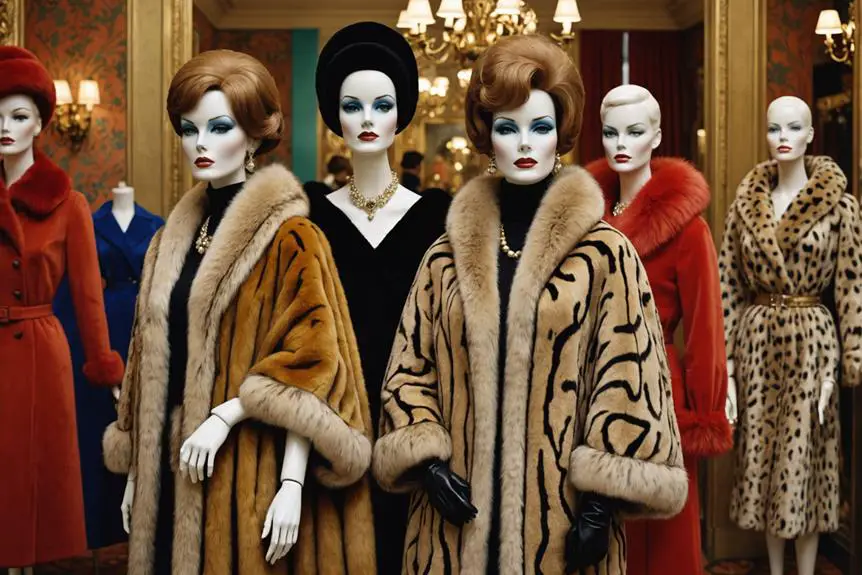
In the vibrant fashion landscape of the 1960s, the debate between faux and real fur emerged as a defining topic among consumers and designers alike. Faux fur became increasingly popular due to its affordability and accessibility, especially among those concerned about animal welfare. In contrast, real fur symbolized luxury and high fashion, often favored by the upper class. However, faux fur's quality improved remarkably during this era, making it a compelling sustainable fashion alternative.
| Feature | Faux Fur | Real Fur |
|---|---|---|
| Price | More affordable | Higher prices |
| Ethical Concerns | Often considered ethical | Associated with animal welfare issues |
| Durability | Improved but less durable | Highly durable |
| Market Presence | Rising in mainstream fashion | Strong but facing challenges |
| Fashion Status | Chic and modern | Classic luxury |
As awareness of animal rights grew in the 1960s, designers began incorporating faux fur into their collections, signaling a shift towards more ethical fashion choices. While real fur maintained its allure, the conversation around fashion alternatives like faux fur set the stage for future trends in sustainable fashion.
Care and Maintenance
Maintaining the quality of 1960s fur stoles, whether faux or real, requires careful attention to storage and cleaning practices. Start by storing your stoles in a cool, dry place, away from direct sunlight. This prevents fading and damage, guaranteeing the vibrancy of the fur remains intact. Regular brushing with a soft-bristle brush is essential; it removes dust and dirt while keeping the fur looking fresh and voluminous.
Moisture is the enemy of fur stoles. If your stole gets wet, gently air dry it away from heat sources. Avoid using hairdryers or heaters, as these can cause irreversible damage. For deep cleaning, always consult a fur specialist. Regular detergents can compromise the delicate fibers and linings, leading to deterioration over time.
To protect against moth damage, use cedar blocks or other natural moth repellents in your storage area. Additionally, verify your stoles are clean before putting them away for long periods. By following these care and maintenance tips, you'll preserve the elegance of your 1960s fur stoles, ensuring they remain a cherished part of your wardrobe for years to come.
Legacy of 1960s Stoles

The legacy of 1960s fur stoles is a fascinating reflection of the decade's intertwining of fashion, culture, and evolving societal values. During this time, you saw fur stoles, often made from luxurious mink and fox fur, emerge as essential fashion accessories, synonymous with glamour and sophistication. Their high-quality craftsmanship and intricate designs appealed to the affluent consumer base, making them staples for evening gowns and formal events.
However, as the 1960s progressed, shifting societal attitudes began to influence public opinion on fur. Ethical concerns regarding animal rights started to surface, laying the groundwork for a decline in the popularity of fur stoles in later decades. Despite this, vintage 1960s fur stoles have become coveted items for collectors and fashion enthusiasts alike, appreciated for their unique designs and historical significance.
| Material | Popularity in 1960s | Current Collector Value |
|---|---|---|
| Mink Fur | High | Very High |
| Fox Fur | Moderate | High |
| Vintage Stoles | Increasing | Highly Sought After |
Ultimately, the legacy of 1960s fur stoles encapsulates a pivotal moment in fashion history, highlighting both the allure of glamour and the rising awareness of ethical practices.
Frequently Asked Questions
What Years Were Fur Stoles Popular?
Fur stoles saw immense popularity from the mid-Victorian era through the late 1960s. You'll notice they became essential accessories for formal wear, reflecting the era's glamour and social status, especially among celebrities and high-profile events.
Did They Wear Fur in the 60s?
Yes, you'll find that fur was quite popular in the 60s. Women wore it to elevate their fashion, associating it with elegance and luxury, despite growing awareness around animal rights and the rise of faux alternatives.
How Do You Wear a Fur Stole?
To wear a fur stole, drape it elegantly over your shoulders for a sophisticated look, or wrap it around your neck with a brooch for structure. Pair it with contrasting colors to enhance its richness.
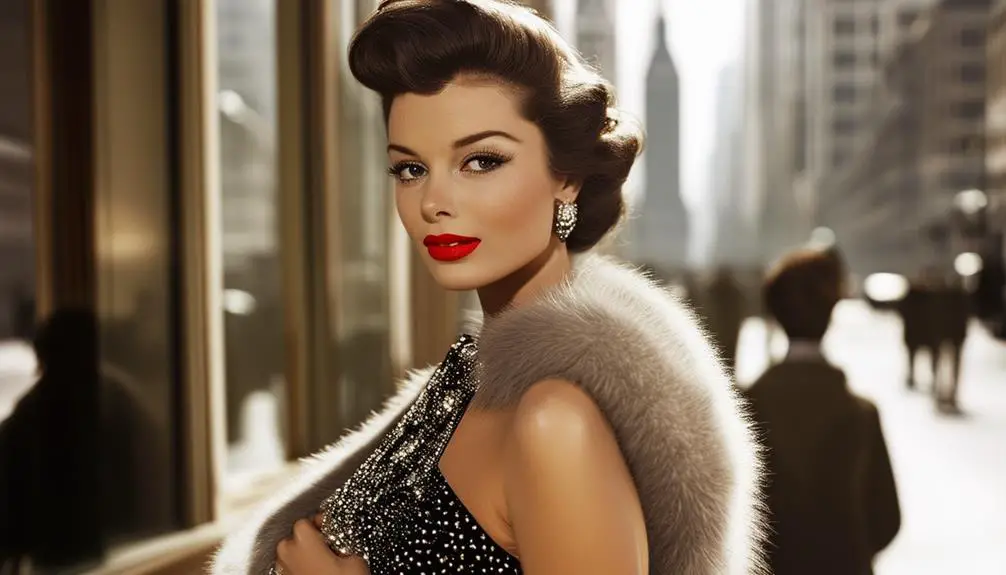

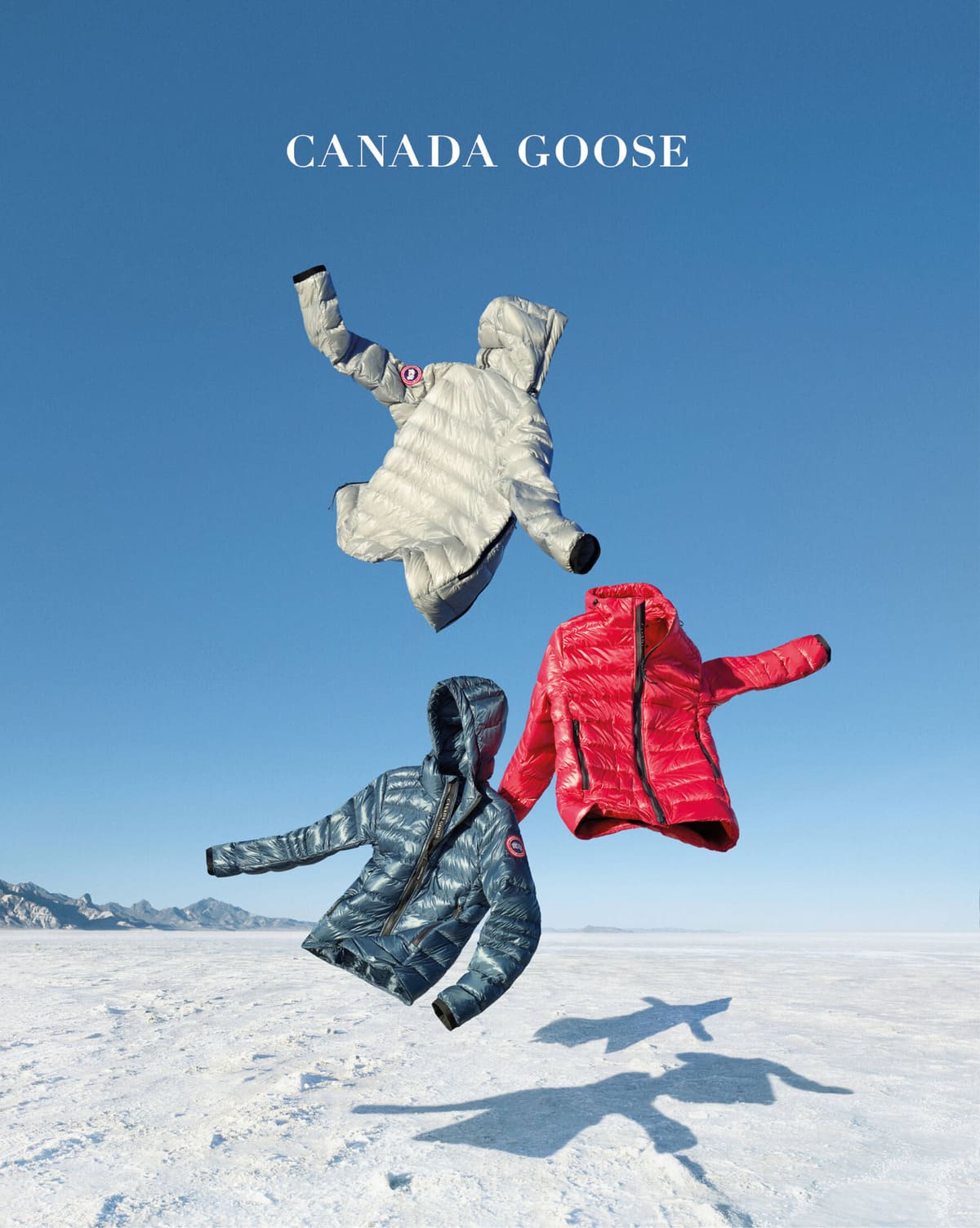
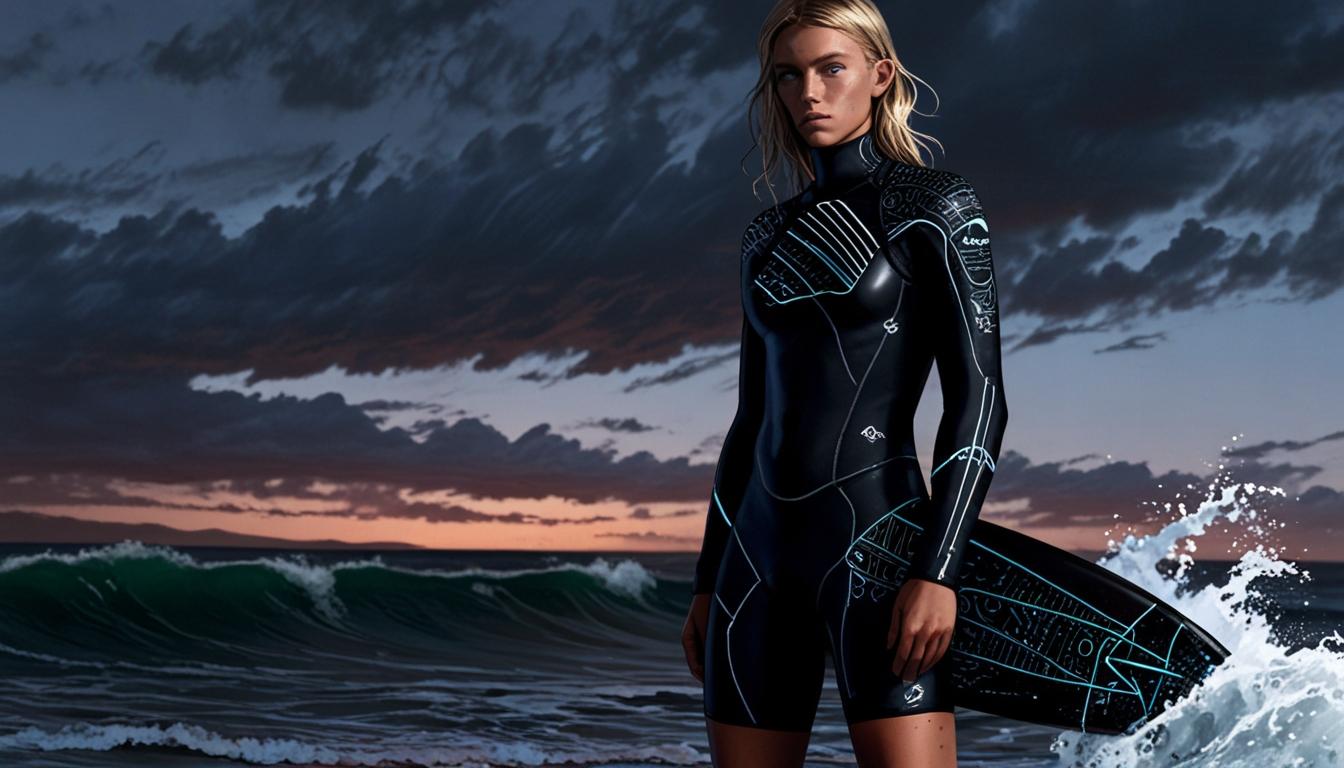
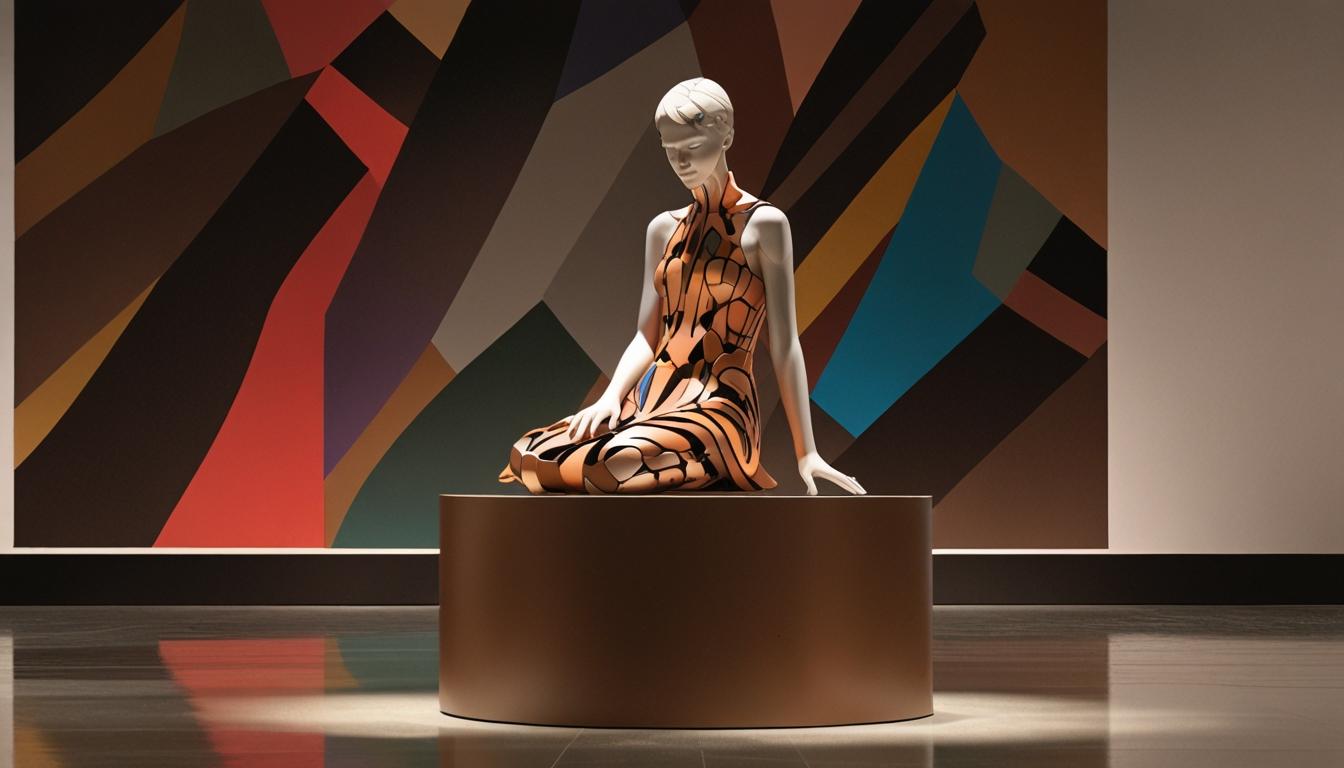
Your point of view caught my eye and was very interesting. Thanks. I have a question for you.